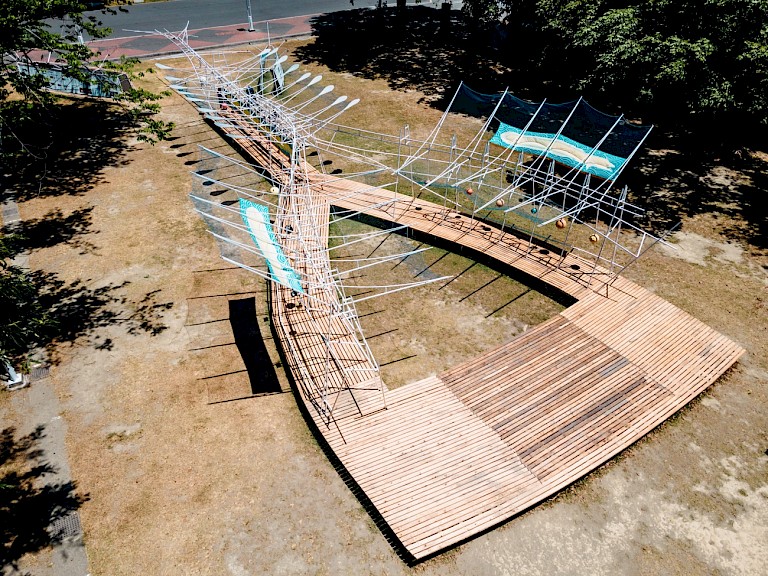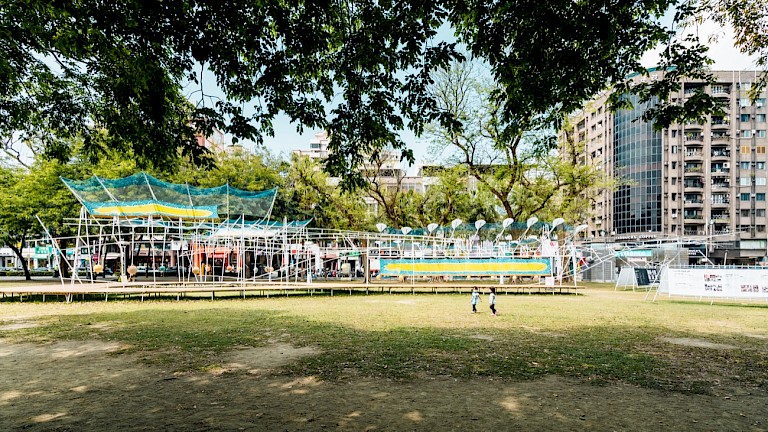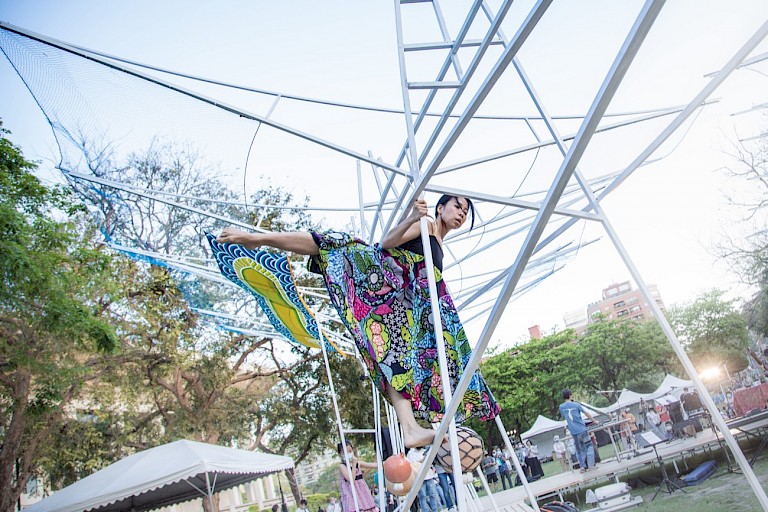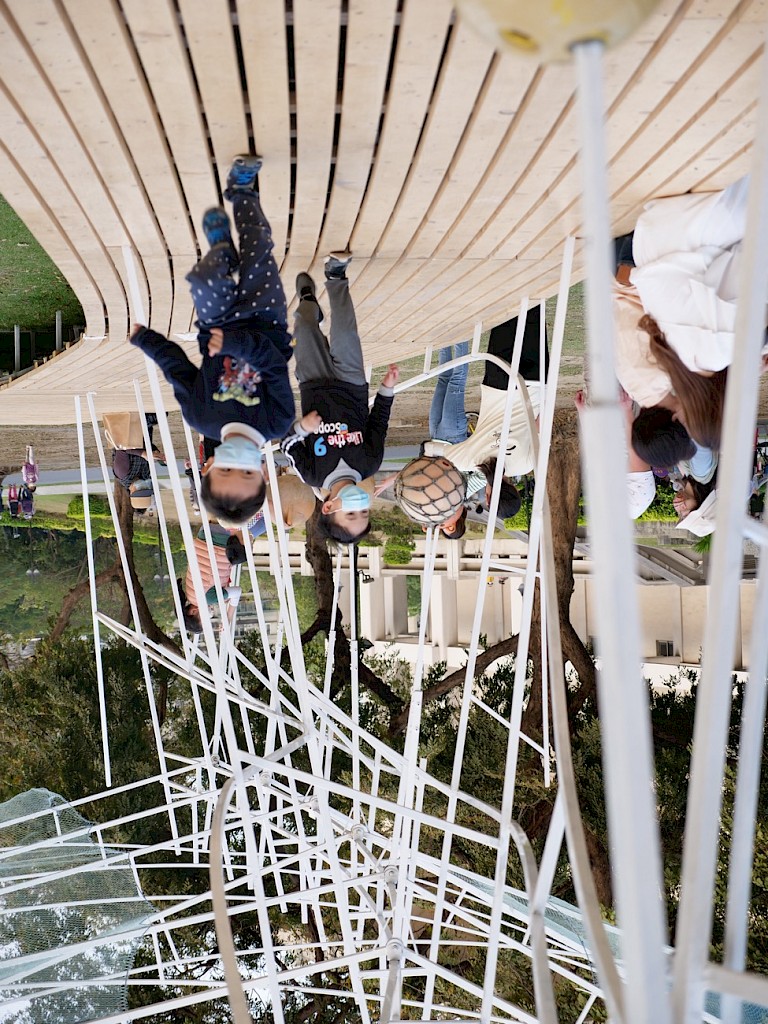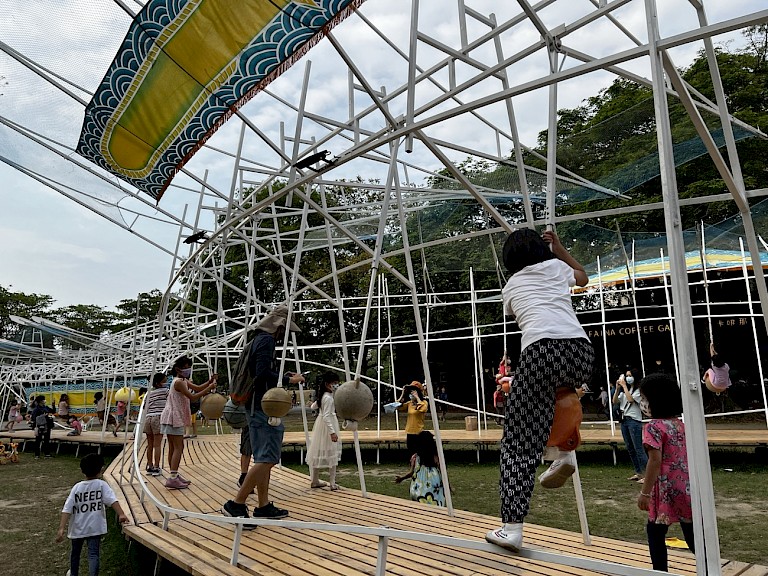



"Swirling Echoes of the Eel" is not only an art piece but also a spatial installation filled with structure and cleverly conceived movement lines. This installation incorporates several outcomes from the art participation project "Replay the Ocean: Sound Form, New Ecological Wave": the large fishing flag printmaking workshops from the surrounding areas of the Kaoping River basin (Linyuan, Daliao, Dashu, Qishan, Meinong, Liugui, Maolin, Namaxia, Taoyuan District), the sound collection workshops in Yanchao, Dashe, and Renwu Districts, and the musical creations from two "Creative Action Plans" - the collection of fishing songs from Kaohsiung's Qijin District and the body project in the Yancheng District. These parts, some completed by artists from different fields and some by the public, were re-created by artists and assembled on "Swirling Echoes of the Eel," making it not only a work that spans contemporary visual arts, architecture, cultural geography, traditional crafts, and sound art, but also a collective creation filled with collective memories.
At the same time, from the beginning of its creation, ample space was retained in its form, making the artwork also a performance stage for bands and physical performers in the project, combining visual and performing arts in one."Swirling Echoes of the Eel," as a collective creation of the "Replay the Ocean: Sound Form, New Ecological Wave" project, can be understood in four parts.
The primary form and structure of the artwork were completed by the "Group B" creative team from Tainan University of the Arts. "Group B" is the Institute of Architectural Arts at Tainan University of the Arts, currently composed of students led by Professor Zheng Chengqi from the "Field, Structure, Action Group." Continuing the renowned spirit of the "Architecture Breeding Ground" from the university, they explore materials and interpret how to intervene in space through the work's form and structure, forming a new organic relationship between humans and the environment. In such creation, change and uncertainty are emphasized, presented through the hermeneutic aesthetic concept of "play (spiel)." This "play" is an interaction between the creator and the work, the work and its environment, and of course, with the viewer. As it's a "game," it's played by the creators. Unlike many public artworks designed by artists and then manufactured by factories, Group B's works are personally completed by the university's faculty and students, combining precise architectural design with a handcrafted roughness.
The second major component of "Swirling Echoes of the Eel" is three long fishing flags, about 20 meters in total, themed around eels, created by the Kaohsiung local cultural team SHANJINWU led by LEE, I-Chih. These "fishing flags," with their vibrant colors and concrete patterns, have been present in Kaohsiung Harbor since the 1930s and still accompany the harbor's fishermen, symbolizing strong blessings. The flags on "Swirling Echoes of the Eel" reinterpret traditional totems with contemporary lines and elements through traditional Japanese resist-dyeing techniques, becoming an essential symbol of local cultural revival.
The third main part of "Swirling Echoes of the Eel" is the outcome of the "Listening to Secret Crystals" segment from the "Replay the Ocean: Sound Form, New Ecological Wave" project. Traditional fishing songs collected from the "Fish Sound: Big Catch Flags" residency project, music created by artist Cai Shan for the "Spin! Yancheng" public performance, and field sounds collected by sound artist Xie Fengzhen from Yanchao, Dashe, and Renwu districts, all contribute to the sound installation of "Swirling Echoes of the Eel," echoing day and night in the Kaohsiung Cultural Center.
Lastly, next to the main artwork of "Swirling Echoes of the Eel," on the extended form components also created by Group B, is the display of the philosophy of the "Replay the Ocean: Sound Form, New Ecological Wave" project and the results of all the workshops.
In summary, although the installation of "Swirling Echoes of the Eel" lasted only a month, it's not just a unique interactive piece brought to the venue by the artist. It's a collective creation by multiple creators, co-created by the public, encapsulating the collective cultural codes of the mountains and seas of Greater Kaohsiung."
From the researcher -
During the ""Replay the Ocean: Sound Form, New Ecological Wave"" project, over 50 art workshops or cultural lectures were held, with at least one in each of the 38 administrative districts, as well as workshops derived from the artist residency program. Despite the severe Covid-19 outbreak in Taiwan during the project's duration, each workshop and lecture still attracted an average of 15-30 participants, with some even reaching 40-50 attendees. Those who participated in these workshops and lectures were aware that their contributions would culminate in ""Swirling Echoes of the Eel."" From this, it can be roughly estimated that at least about 1,000 Kaohsiung residents deeply engaged with this project, gaining a deeper understanding of their city's local culture through participatory creation.
The ""Replay the Ocean: Sound Form, New Ecological Wave"" project included a public art international forum held at the National Kaohsiung Normal University. This forum discussed the project and the ""Swirling Echoes of the Eel"" artwork. It focused on three themes: "" Programmatic Public Art,"" ""Cross-disciplinary Public Art,"" and ""New Genre Public Art."" Artists and scholars from Taiwan, Singapore, and Malaysia were invited to share and exchange ideas on these themes, followed by a site visit to the artwork. In this regard, ""Swirling Echoes of the Eel,"" as the main piece of the project, showcased Taiwan's forefront in participatory public art creation and the cutting-edge aesthetic expressions of the Tainan University of the Arts' Institute of Architectural Arts.
The Kaohsiung Cultural Center, where ""Swirling Echoes of the Eel"" was installed, is a bustling place on regular days. Although there's no official statistical data, during the installation period, at least several thousands to tens of thousands of people must have viewed the artwork and understood the project's essence through the text on the installation. Especially in the evenings and on weekends, parents often accompanied their children to play around the artwork, with dozens of children frolicking on it at peak times. Generally, Kaohsiung is not a city that frequently holds large visual art events, and participatory public art is even rarer. ""Swirling Echoes of the Eel"" can be described as a rare, joyous, and culturally rich art feast for all Kaohsiung residents in recent years.
During the installation period of ""Swirling Echoes of the Eel,"" many residents expressed their admiration for the artwork, leading to requests for its continuation. As a result, the Kaohsiung City Cultural Bureau decided to extend the exhibition for another two months at the Linyuan Wetland Park in the Linyuan District of Kaohsiung. The popularity and appreciation of the artwork among the public can be inferred from this extension."
